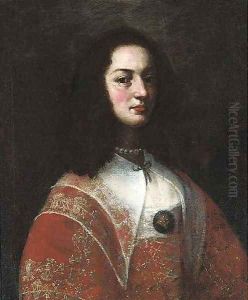Justus Susterman Paintings
Justus Sustermans, also known as Giusto Sustermans, was a Flemish painter who is most famous for his portraits of the Medici family. Born in Antwerp, in the Spanish Netherlands (present-day Belgium), in 1577, he became an influential figure in Italian art during the Baroque period. Sustermans is a renowned example of the cultural exchange between Italy and Flanders in the 17th century, a period when many Flemish artists were active in Italy, bringing with them their distinct Northern European painting techniques.
Sustermans began his artistic training in Antwerp, a city famous for its artistic vibrancy, under the tutelage of Willem de Vos. He continued his education with Antoon van Dyck (before the latter became a prominent artist in his own right). Seeking greater opportunities, Sustermans traveled to Italy in 1608, which was common among Northern European artists at the time. He visited Rome and Florence, among other cities. His career truly began to flourish when he settled in Florence and became the court painter to Cosimo II de' Medici, Grand Duke of Tuscany, in 1621. This position allowed him to establish himself as a leading portraitist in Italy.
While his work covered various subjects, Sustermans is particularly esteemed for his portraits, which are characterized by their clarity, attention to detail, and nuanced depiction of the sitters’ personalities. His portraits of the Medici family, including Cosimo II, Ferdinando II, and other members of the ruling family, solidified his reputation as a portraitist of the highest order. These works are celebrated for their elegance and for capturing the opulence of the Medici court. Sustermans also painted religious and mythological scenes, but these are less well-known compared to his portraiture.
Sustermans' influence extended beyond his own work. He trained a number of apprentices who would carry on his techniques and stylistic choices. His legacy is also evident in the impact he had on the development of Baroque portraiture in Italy. He remained in Florence until his death in 1681, and his works today are housed in numerous collections, including the Uffizi Gallery in Florence and the Louvre Museum in Paris, attesting to the enduring appreciation for his art.
Please note that Sustermans' death date is often listed as 1681, but there is some discrepancy in historical records. Some sources suggest he may have died in 1651. His contributions to the art world during his lifetime, however, remain undisputed.
